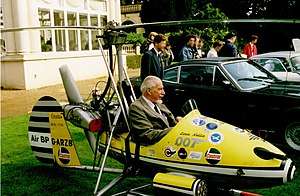Wallis WA-116 Agile
The Wallis WA-116 Agile is a British autogyro developed in the early 1960s by former Royal Air Force Wing Commander Ken Wallis. The aircraft was produced in a number of variants, one of which, nicknamed Little Nellie, was flown in the 1967 James Bond film You Only Live Twice.
| WA-116 Agile | |
|---|---|
 | |
| Little Nellie, pictured with its creator Ken Wallis in the cockpit. | |
| Role | Single-seat autogyro |
| National origin | United Kingdom |
| Manufacturer | Wallis Autogyros Limited |
| Designer | Ken Wallis |
| First flight | 2 August 1961 |
| Number built | 10+ |
Design and development
Wing Commander Ken Wallis, a former RAF pilot, developed a number of improvements to the autogyro design, including the offset gimbal rotor head which gives the autogyro hands-off stability.[1] Wallis' first prototype autogyro, registered G-ARRT, was first flown on 2 August 1961.[2]
Operational history
In 1962, five WA-116s were built by Beagle Aircraft at Shoreham, three of which were for evaluation by the British Army Air Corps, Wallis flying one of these aircraft, XR942, at that year's Farnborough Air Show.[2] In 1966, one of the Beagle-built WA-116s, registered G-ARZB, was modified for use in the James Bond film You Only Live Twice.[3] Little Nellie was named after Nellie Wallace.[4] Few Wallis autogyros have been operated privately, with nearly all of them being used for research and demonstration flying by Wallis himself.[3]
Variants
- WA-116 Agile
- Prototype autogyro powered by a Wallis-McCulloch 4318A engine.[2] [5]
- WA-116-T
- Two-seat variant, one built.[2]
- WA-117 Venom
- Variant powered by a 100 hp (75 kW) Rolls-Royce Continental O-200-B engine.[2]
- WA-118 Meteorite
- Variant powered by a 120 hp (89 kW) Wallis-modified Meteor Alfa supercharged two-stroke engine.[6]
- WA-119
- Variant powered by a 40 hp water-cooled 990 cc Hillman Imp engine.[2]
- WA-121
- Streamlined variant for high-altitude research with a Wallis-McCulloch engine; a single WA-121 was built in 1972.[2]
Specifications (WA-116)
Data from [2]British Civil Aircraft since 1919 – Volume 3
General characteristics
- Crew: 1
- Length: 3.38 m (11 ft)
- Rotor diameter: 6.20 m (20 ft 4 in)
- Height: ()
- Empty weight: 116 kg (255 lb)
- Loaded weight: 249 kg (550 lb)
- Powerplant: 1 × Wallis-McCulloch 4318A piston engine, 54 KW (72 hp)
Performance
- Maximum speed: 161 kmh (100 mph[7])
- Range: 209 km (130 miles)
- Endurance: 2 h 27 min
- Service ceiling: 10,000 ft[7] ()
- Rate of climb: 1,000 ft in 56 s[8] ()
58 lb fuel, power/wt 7.651b/hp[9]
References
Notes
- "The Wallis Autogyros." Flight. 31 March 1966. p. 515.
- Jackson (1974). p. 329.
- Apostolo (1984). p. 101.
- Places & Faces, "The Name's Wallis" (accessed 2013-12-12)
- Note, the McCulloch 4318A is a four cylinder horizontally-opposed two-stroke engine originally intended for limited-life drone applications.
- https://www.flightglobal.com/FlightPDFArchive/1966/1966%20-%201560.PDF
- "The Wallis Autogyros." Flight. 31 March 1966. p. 520.
- "The Wallis Autogyros." Flight. 31 March 1966. p. 518.
- "The Wallis Autogyros." Flight. 31 March 1966. p. 517.
Bibliography
- Apostolo, Giorgio (1984). The Illustrated Encyclopedia of Helicopters. New York: Bonanza Books. ISBN 0-517-439352.
- Jackson, A.J. (1974). British Civil Aircraft since 1919 – Volume 3. London: Putnam & Company Ltd. ISBN 0-370-10014-X.